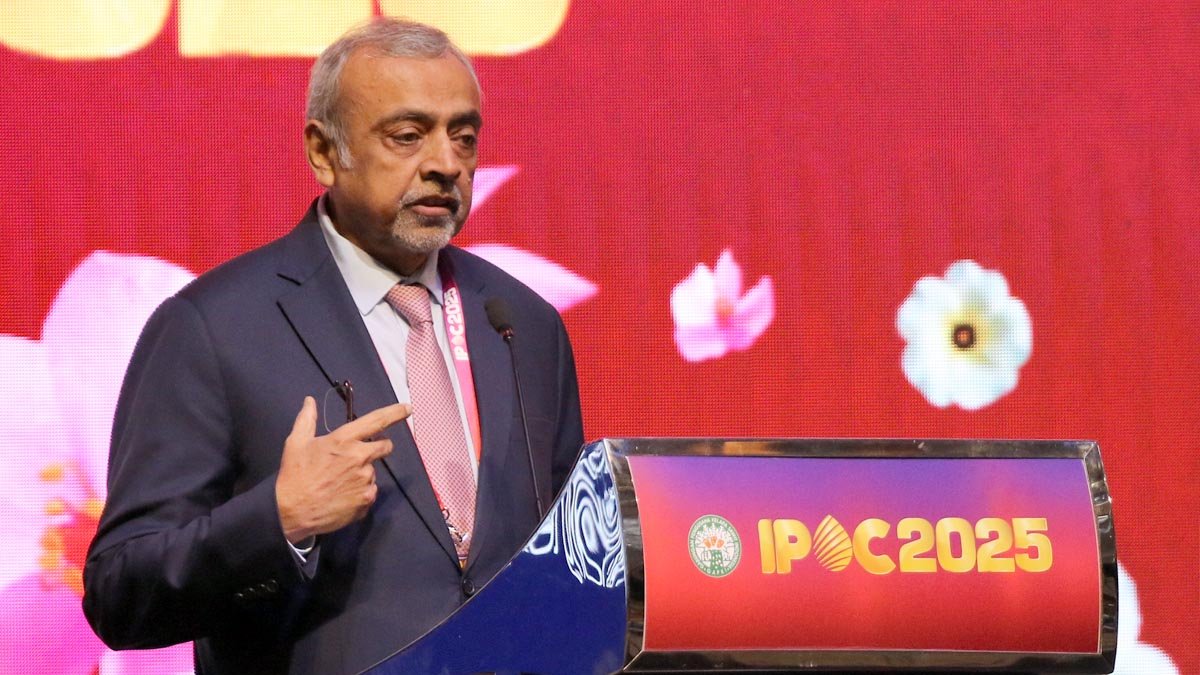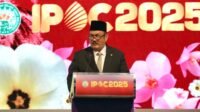PALMOILMAGAZINE, NUSA DUA, BALI — The global vegetable oil market has experienced significant turbulence in recent weeks, driven largely by unexpected surges in palm oil production from Indonesia and Malaysia. Speaking at the Indonesian Palm Oil Conference (IPOC) 2025, Abdul Rasheed Jan Mohammad, CEO of Westbury Group, said that the supply increase—far beyond market expectations—has exerted heavy downward pressure on prices.
“Markets have been shaken, mainly due to production growth in Malaysia and Indonesia that most market players simply did not anticipate,” he said during his presentation in Bali.
Jan Mohammad added that global uncertainty has further magnified volatility. Indonesia’s biodiesel policy remains unclear, while tariff wars among major economies continue to reshape short- and long-term trade flows.
“Indonesia’s stance on B50 is still ambiguous. And the tariff battles remain the dominant factor influencing global dynamics,” he noted.
Also Read: Eddy Abdurrachman: Biodiesel Stabilizes Palm Oil Prices and Secures Indonesia’s Energy at IPOC 2025
Pakistan’s Growing Dependence on Vegetable Oil Imports
With per-capita consumption reaching 18 kilograms, Pakistan’s demand for edible oils continues to rise. Jan Mohammad reported that total national consumption now sits at 4.5 million tons, while domestic production is only 0.5 million tons, forcing imports to climb annually.
“As of October this year, we have received 3 million tons of oil. I expect that in the next two months, Pakistan will end up importing 3.4–3.5 million tons—an increase of about 12 percent from last year,” he said.
Indonesia remains Pakistan’s dominant supplier, controlling around 87–90% of the market for the last four years. However, Pakistan’s tariff structure makes it difficult for local refiners to utilize crude palm oil (CPO).
“Our tariff structure does not allow us to import CPO, and the export taxes imposed by Indonesia and Malaysia also limit our ability to bring in crude palm oil,” he explained.
Complications were worsened when Pakistan temporarily banned GMO soybean and canola imports over the past two years, increasing costs and disrupting supply. The situation improved earlier this year when imports from the U.S. and Brazil resumed, totaling 1.75 million tons of soybeans in 2025.
In this context, Indonesia’s B50 mandate remains a critical variable influencing global supply availability. Jan Mohammad questioned whether accelerating B50 is appropriate during a period of weak crude oil prices.
“Do we really need to move to B50 when crude prices are low? And the bigger question—should palm oil be prioritized for food or for fuel?” he asked.
He warned that a full implementation of B50 would significantly tighten supplies for importing countries such as Pakistan.
Also Read: India’s Palm Oil Policy Crossroads: Balancing Tariffs, Subsidies, and Regional Trade Dynamics
ASEAN Palm Oil Production Expected to Decline in 2025–2026, With B50 as a Key Market Driver
Palm oil production across Southeast Asia is projected to weaken in the 2025–2026 cycle. According to Kian Pang Tan, Analyst at LSEG Singapore, the decline is attributed to structural plantation challenges, prolonged dry weather, and global trade pressures.
Tan highlighted external headwinds: the IMF expects major economies to slow further in 2026, with China at 4.2%, India at 6.2%, and the EU at 1.1%.
“U.S. tariffs and escalating trade tensions with China are already disrupting trade flows and increasing pressure on global commerce,” Tan said.
LSEG projects that Indonesia’s production will decline due to aging trees, slow replanting, stricter land regulations, and mid-year drought. Malaysia’s output is also expected to shrink slightly to 19.2 million tons, held back by insufficient replanting (just 2% out of the 4% target) and disease pressures.
Thailand is the only country expected to record slight growth, reaching 3.58 million tons, potentially a new record.
Indonesia’s May–July dry season hit Aceh and North Sumatra the hardest—regions that jointly contribute 14% of national output.
“These areas are of particular concern because prolonged dryness could affect yields during the 2035–2036 season,” Tan explained.
Developing La Niña conditions could cause heavy rainfall and localized flooding, disrupting harvesting further.
On the demand side, Indonesian exports may drop by 1.5–3 million tons if B50 is fully implemented. Domestic consumption is expected to grow 1–3 million tons, primarily driven by the biodiesel mandate.
“B50 could raise Indonesia’s biofuel demand to 19–20 million kiloliters, up from 15.6 million kiloliters today,” Tan said.
The shift could create a window for Malaysia to boost its exports by up to 1 million tons, especially since its shipments fell 9.5% from January to October due to higher RBD prices compared to Indonesia.
U.S. Trade Escalation Threatens Indonesia’s Export Competitiveness as Malaysia Gains Ground
According to Alvin Tai, Bloomberg Commodity Analyst, evolving trade relations among Indonesia, Malaysia, and the United States will be decisive for the future of Indonesian palm oil exports. Malaysia, he noted, has advanced more quickly in securing trade access to the U.S., while Indonesia’s negotiations remain stalled.
Malaysia has already signed a trade agreement with the U.S., granting it a 19% import duty and zero tariffs for key commodities such as palm oil, cocoa, and rubber. However, these benefits come with heavy commitments.
“Malaysia must purchase USD 150 billion worth of semiconductors, aerospace components, and data-center equipment over five years,” Tai said.
It must also buy USD 204 billion in coal and channel USD 70 billion into capital investments.
By contrast, Indonesia’s draft trade proposal with the U.S. remains unresolved. Under the framework released by the White House in July, Indonesia would be required to purchase USD 15 billion in U.S. energy products annually, plus USD 4.5 billion in agricultural goods, and buy 50 Boeing aircraft over a set period.
“Indonesia must also eliminate tariffs on 99% of U.S. food and agricultural industrial products. Most importantly, Indonesia must dismantle non-tariff barriers for American agricultural goods,” Tai added.
He emphasized that the removal of non-tariff barriers is the most sensitive requirement. Without them, U.S. agricultural products—especially corn—could enter Indonesia more freely. Local corn currently trades at up to 150% above international prices; increased imports could compress price gaps and benefit the poultry sector, which faces high feed costs.
Malaysia Takes Advantage as Indonesia’s Exports Decline
Indonesia exported 1.54 million tons of palm oil to the U.S. in 2024 worth USD 1.59 billion. But in the first seven months of this year, exports plunged 25.8%. Meanwhile, Malaysia seized the opportunity, with its exports to the U.S. nearly matching its full-year 2024 volume in just seven months.
“Every time Indonesia ships less, Malaysia fills the gap,” Tai said.
The U.S. energy sector—especially renewable diesel—faces a structural shortage of vegetable oil feedstocks. Even with rising soybean crushing capacity expected to reach 2.78 billion bushels by 2030, U.S. soybean oil production will still fall short. The U.S. requires 43 billion pounds of feedstock but only has 34.5 billion pounds available, leaving a deficit of about 4 billion pounds, even with Canadian and Mexican supplies.
This should create more room for palm oil, Tai explained, but Indonesia risks losing its foothold if it retreats from the U.S. market—especially as China and India are already reducing palm oil imports due to pricing that is less competitive than soybean oil.
Domestic Policies Add More Pressure
Indonesia’s B50 mandate could require an additional 3.5 million tons of palm oil, which Tai warned could undermine export volumes and worsen Indonesia’s trade balance.
“Indonesia’s balance of payments has slipped into negative territory, and this is partly tied to declining exports. Forward currency markets suggest the rupiah may fall to new record lows against the U.S. dollar,” he said.
The rupiah has already weakened to historic lows against the Singapore dollar, Malaysian ringgit, Thai baht, and Vietnamese dong.
In closing, Tai cautioned Indonesia to be extremely careful in balancing domestic energy ambitions with export needs.
“Indonesia must maximize exports to avoid a trade deficit. The B50 plan runs counter to this objective,” he concluded.
Stay up to date with the latest IPOC 2025 news at Palmoilmagazine.com. (P3)





































